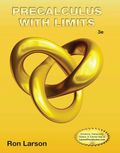
Concept explainers
(a)
To identify : The degree of function as odd or even, the leading coefficient as positive or negative, then graph the function and the right and left hand behaviour.
(a)
Explanation of Solution
Given: The function is
According to the leading coefficient test, as
When
When
Now consider the function.
The degree of the function is
The leading coefficient of the function is
The degree of the function is odd and the leading coefficient is positive. So, the graph falls to the left and rises to the right side.
The graph of function is shown in figure below.
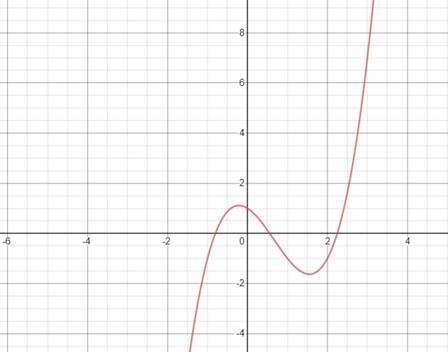
Figure (1)
(b)
To identify : The degree of function as odd or even, the leading coefficient as positive or negative, then graph the function and the right and left hand behaviour.
(b)
Explanation of Solution
Given: The function is
According to the leading coefficient test, as
When
When
Now consider the function.
The degree of the function is
The leading coefficient of the function is
The degree of the function is odd and the leading coefficient is positive. So, the graph falls to the left and rises to the right side.
The graph of function is shown in figure below.

Figure (2)
(c)
To identify : The degree of function as odd or even, the leading coefficient as positive or negative, then graph the function and the right and left hand behaviour.
(c)
Explanation of Solution
Given: The function is
According to the leading coefficient test, as
When
When
Now consider the function.
The degree of the function is
The leading coefficient of the function is
The degree of the function is odd and the leading coefficient is negative. So, the graph rises to the left and falls to the right side.
The graph of function is shown in figure below.
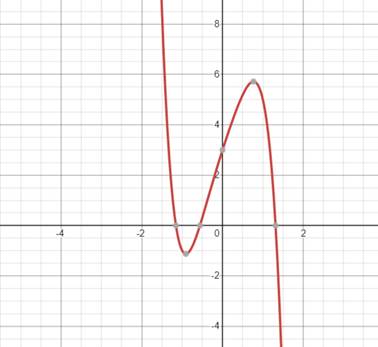
Figure (3)
(d)
To identify : The degree of function as odd or even, the leading coefficient as positive or negative, then graph the function and the right and left hand behaviour.
(d)
Explanation of Solution
Given: The function is
According to the leading coefficient test, as
When
When
Now consider the function.
The degree of the function is
The leading coefficient of the function is
The degree of the function is odd and the leading coefficient is negative. So, the graph rises to the left and falls to the right side.
The graph of function is shown in figure below.
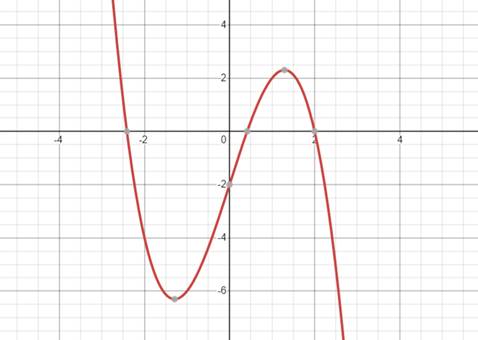
Figure (4)
(e)
To identify : The degree of function as odd or even, the leading coefficient as positive or negative, then graph the function and the right and left hand behaviour.
(e)
Explanation of Solution
Given: The function is
According to the leading coefficient test, as
When
When
Now consider the function.
The degree of the function is
The leading coefficient of the function is
The degree of the function is even and the leading coefficient is positive. So the graph rises to the left and right.
The graph of function is shown in figure below.

Figure (5)
(f)
To identify : The degree of function as odd or even, the leading coefficient as positive or negative, then graph the function and the right and left hand behaviour.
(f)
Explanation of Solution
Given: The function is
According to the leading coefficient test, as
When
When
Now consider the function.
The degree of the function is
The leading coefficient of the function is
The degree of the function is even and the leading coefficient is positive. So the graph rises to the left and right.
The graph of function is shown in figure below.
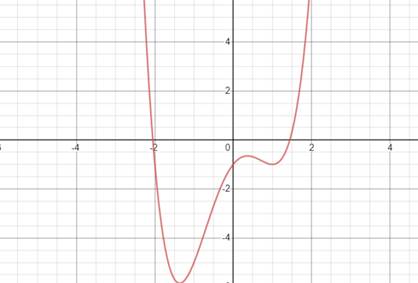
Figure (6)
(g)
To identify : The degree of function as odd or even, the leading coefficient as positive or negative, then graph the function and the right and left hand behaviour.
(g)
Explanation of Solution
Given: The function is
According to the leading coefficient test, as
When
When
Now consider the function.
The degree of the function is
The leading coefficient of the function is
The degree of the function is even and the leading coefficient is positive. So the graph rises to the left and right.
The graph of function is shown in figure below.
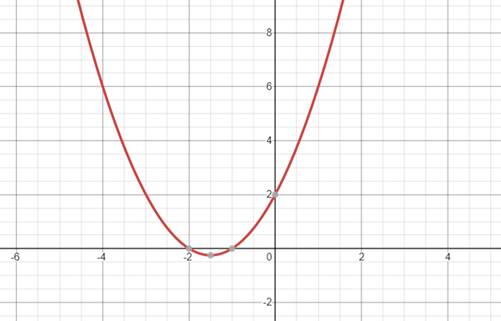
Figure (7)
Chapter 2 Solutions
EBK PRECALCULUS W/LIMITS
 Calculus: Early TranscendentalsCalculusISBN:9781285741550Author:James StewartPublisher:Cengage Learning
Calculus: Early TranscendentalsCalculusISBN:9781285741550Author:James StewartPublisher:Cengage Learning Thomas' Calculus (14th Edition)CalculusISBN:9780134438986Author:Joel R. Hass, Christopher E. Heil, Maurice D. WeirPublisher:PEARSON
Thomas' Calculus (14th Edition)CalculusISBN:9780134438986Author:Joel R. Hass, Christopher E. Heil, Maurice D. WeirPublisher:PEARSON Calculus: Early Transcendentals (3rd Edition)CalculusISBN:9780134763644Author:William L. Briggs, Lyle Cochran, Bernard Gillett, Eric SchulzPublisher:PEARSON
Calculus: Early Transcendentals (3rd Edition)CalculusISBN:9780134763644Author:William L. Briggs, Lyle Cochran, Bernard Gillett, Eric SchulzPublisher:PEARSON Calculus: Early TranscendentalsCalculusISBN:9781319050740Author:Jon Rogawski, Colin Adams, Robert FranzosaPublisher:W. H. Freeman
Calculus: Early TranscendentalsCalculusISBN:9781319050740Author:Jon Rogawski, Colin Adams, Robert FranzosaPublisher:W. H. Freeman
 Calculus: Early Transcendental FunctionsCalculusISBN:9781337552516Author:Ron Larson, Bruce H. EdwardsPublisher:Cengage Learning
Calculus: Early Transcendental FunctionsCalculusISBN:9781337552516Author:Ron Larson, Bruce H. EdwardsPublisher:Cengage Learning





